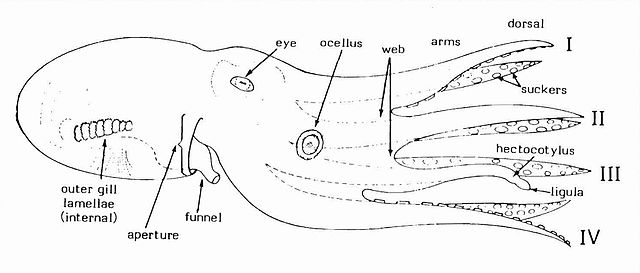California two-spot octopus
The California two-spot octopus, often simply called a "bimac", is an octopus species native to many parts of the Pacific Ocean including the coast of California. One can identify the species by the circular blue eyespots on each side of its head. Bimacs usually live to be about two years old. They are closely related to Verrill's two-spot octopus. In 2015, the genome was sequenced.
California two-spot octopus
An octopus is a soft-bodied, eight-limbed mollusc of the order Octopoda. The order consists of some 300 species and is grouped within the class Cephalopoda with squids, cuttlefish, and nautiloids. Like other cephalopods, an octopus is bilaterally symmetric with two eyes and a beaked mouth at the center point of the eight limbs. The soft body can radically alter its shape, enabling octopuses to squeeze through small gaps. They trail their eight appendages behind them as they swim. The siphon is used both for respiration and for locomotion, by expelling a jet of water. Octopuses have a complex nervous system and excellent sight, and are among the most intelligent and behaviourally diverse of all invertebrates.
Octopus
A giant Pacific octopus at Echizen Matsushima Aquarium, Japan
Diagram of octopus from side, with gills, funnel, eye, ocellus (eyespot), web, arms, suckers, hectocotylus and ligula labelled.
A finned Grimpoteuthis species with its atypical octopus body plan





